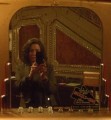Not just for “Appearances” sake: ASK and Frida Kahlo
Our major exhibition for this spring, Frida Kahlo: Appearances Can Be Deceiving, has been very well-attended and well-received so far. It has also posed unique opportunities and unexpected challenges for ASK, as every special exhibition tends to do.
We knew at the outset that we’d be working around one major restriction: photography is not permitted within this exhibition. We devised a pre-exhibition ASK activity (a trivia quiz) for David Bowie is last year, and this time we came up with a post-exhibition experience to prolong visitors’ post-Kahlo excitement.
With their usual flair and extensive knowledge of our collections, the ASK team collaborated on shaping four ASK-guided tours of the Museum. Each tour would direct the visitor to works that related to the main themes of Frida Kahlo, sharing interesting context and information at every “stop. The four tour themes would be Mexican identity, modernism, feminisms (works by women or works addressing themes of female identity), and “the art of the personal” (artist that draw upon autobiography in similar ways to Kahlo), and the visitor would pick their favorite card to get started. (We also assembled a tour limited to the Museum’s first floor, to offer on Mondays and Tuesdays when the rest of the building is closed.)
To create special materials for this exhibition activity, we selected four images of Kahlo from the exhibition checklist, and our Design colleagues crafted four palm cards to share with visitors. Each card featured a different image on the front, and the backs all included the same basic information (including our ASK texting number), in both English and Spanish.
Starting on the first day of the exhibition, the cards were displayed in a rack in the show’s exit space, near our “Frida selfie spot” and just below some ASK wall signage. An ASK Ambassador was stationed nearby to explain the activity, to assist with any technical issues, and to restock the cards when needed. We all agreed that the cards looked fantastic.
As it turned out, however, we’d created something a little too appealing. As visitors moved from the last gallery of the exhibition into the exit space, they spotted the cards from a distance and made a beeline for them. They were so focused on the cards, and on the goal of taking them as souvenirs, that they weren’t paying much attention to the accompanying wall signage or to the Ambassadors’ pitches. When the Ambassadors gently encouraged them to “choose your favorite card” (rather than multiples or all four designs), visitors wanted to know whether they could also buy the cards in our museum shop.

Redesigned palm cards feature smaller images and give more weight to promotional copy and instructions.
Back to the proverbial drawing board! I discussed a few options with our Design colleagues, and they came up with an alternative card design that presents a different overall appearance and foregrounds our engagement angle. The front of each card has a significantly smaller image with introductory text below it. The reverse of the card continues the instructions and offers the texting number.

Our Ambassadors found that visitors were more likely to read signage and listen to pitches after the cards were updated.
About a week ago, the Ambassadors began pitching with the new cards. Based on early feedback, there are still some pros and cons, but the cards’ purpose is now clearer. Visitors are quickly identifying them as “educational material” of some kind rather than apparent souvenirs. Gina, one of our Ambassadors, has noted, “Visitors aren’t approaching as aggressively with these new cards, which is great! They are instead reading a lot more as they approach—both the cards and the wall text. It seems like they are getting the idea that this is something to do rather than something to take.” She added, “The number of ‘Do you sell these in the gift shop’ inquiries have decreased a lot!”
Frida Kahlo: Appearances Can Be Deceiving runs through May 12, so we we’ll be tracking our engagement rates for the final month of the show. We’ll report back on the results of the card switch as well as overall success of the two ASK-related activities associated with the exhibition.

Jessica Murphy, Manager of Visitor Engagement, joined the Brooklyn Museum in 2015 as a member of the ASK team. In her current position she leads the team in their interactions with the Museum’s visitors through the ASK app and coordinates their ongoing training and development. Jessica received her B.A. from Fordham University and her M.A. and Ph.D. in Art History (with a concentration in American Art) from the University of Delaware. She previously worked as Research Associate at the Metropolitan Museum of Art (contributing to exhibitions and publication such as “Alfred Stieglitz and His Artists: Matisse to O’Keeffe” and “The American West in Bronze”), as Contractual Educator at the Met, and as Curatorial Assistant at the Philadelphia Museum of Art. She has also worked as a freelance writer on cultural topics. She welcomes any opportunity, in any medium, to connect people and art.




Start the conversation